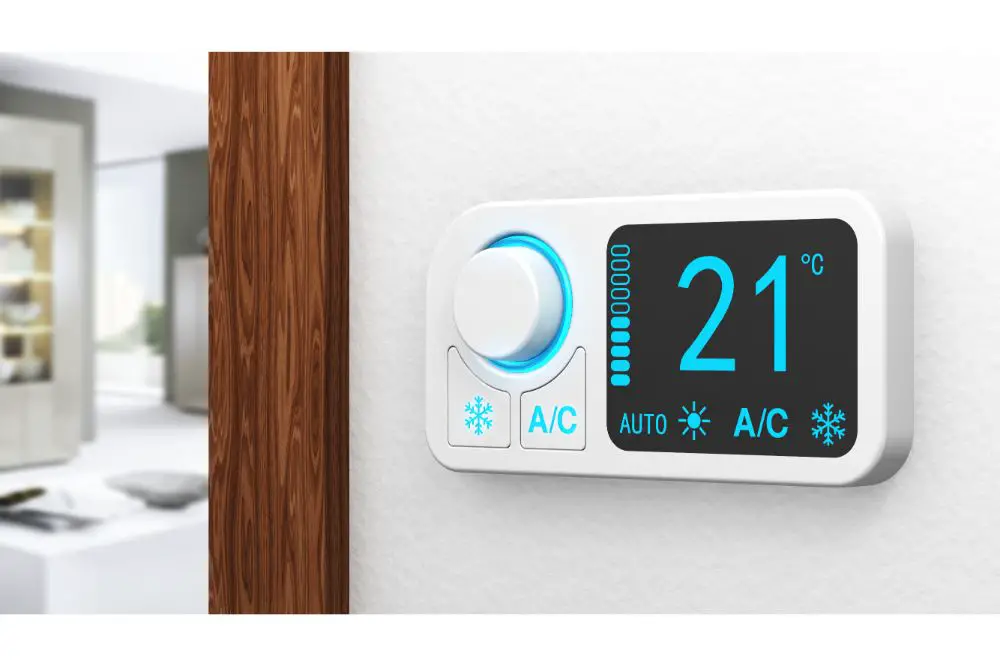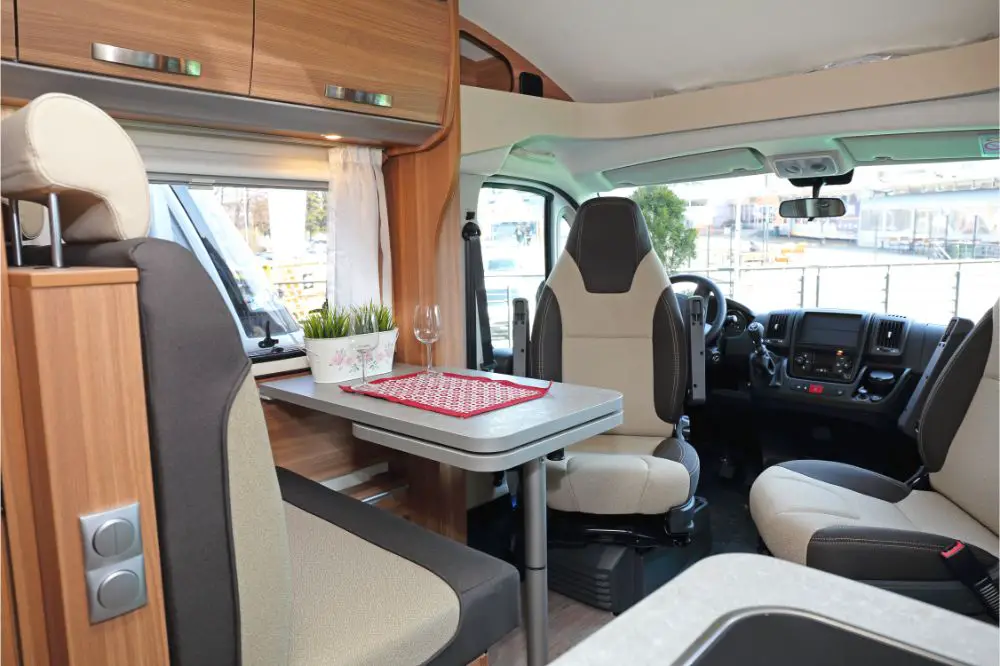Published Date: September 9, 2022
Last Updated on March 24, 2023 by
If you want to be able to travel in total comfort, then you’re going to want a thermostat in your RV that provides you with precise control of the interior temperature of your motorhome. But getting your hands on one is far easier said than done.
There are hundreds of RV thermostats on the market, each with different features and functions. While you could invest in one of these expensive models, you could also install a low-voltage digital home thermostat that will cost you far less money and be more budget-friendly while you’re adventuring.
We are going to take a look at what you need to know about thermostats in your RV. Read on to learn more about household thermostats and their compatibility with RVs.
Table of Contents
Using a Household Thermostat in Your RV
RV thermostats operate on 12V DC power, so they cannot be replaced with 24V AC-only home thermostats. But, all hope is not lost – digital home thermostats work with onboard batteries, which allows them to regulate motorhome furnaces and air conditioners to create a temperature-accurate, versatile climate control system.
Many RV enthusiasts will claim that it’s impossible to install a household thermostat in your mobile home, while others say they can do it easily. In reality, it is entirely possible to replace your 12V digital or analog RV thermostat with a battery-operated, programmable digital household model.
Choosing a Household Thermostat For an RV
The great thing about digital home thermostats is that they are made to regulate a wide range of appliances that make up your climate control setup. This includes fans, air conditioners, blowers, and propane thermostats.
What’s more, digital thermostats manage both your 12V DC and 120V AC climate control systems. However, you should keep in mind that digital household thermostats only use their internal battery DC power.
These thermostats also use universal circuit configurations, which makes them suitable to use for a range of heaters and air conditioners, including ones found in most motorhomes. The most popular brands can be managed with digital household thermostats, and the same goes for RV furnaces like Atwood, Suburban, and Truma.
Digital household thermostats will manage and synchronize your RV’s climate control system while making sure that your cooler and heater work harmoniously. New home thermostats also generally come with instruction manuals that detail their installation processes, as well as include tips and diagrams to ensure that you use them properly.
RV Thermostats VS Household Thermostats – What’s the Difference?
One of the primary differences – and, as such, issues – with using a home thermostat in an RV has to do with the fact that household thermostats operate using 24V AC currents, while RV batteries generally only provide 12V DC with no inverters or voltage converters.
Household thermometers usually draw power from transformers that create 24AV power from 120V AC power. This allows your thermostat to alternate between the home furnace and air conditioning, depending on the selected temperature settings.
The transformer can generally be found in the furnace, air conditioner, or electrical panel. Sometimes, both have transformers that power household thermostats when either is turned on. While household thermostats can either be digital or analog, both operate using 24V AC power.
RV thermostats provide temperature control by regulating the activation of your air conditioner and propane furnace. They are also powered through 12V DC currents, which are taken from the batteries of your motorhome.
On the other hand, new digital home thermostats come with integrated batteries, providing them with full functionality without needing any external power source. Most of these thermostat models are able to power gas heaters and electric coolers.
It goes without saying that the wiring in a household thermostat is quite different from that found in your average RV thermostat. But, with a low-voltage household thermostat that is compatible with your RV, some DIY electrical know-how, and a good wiring diagram, you’ll be able to regulate your RV’s air conditioning hassle-free.

What RV Thermostats Do
If you enjoy staying warm when it’s cold and cool when it’s hot, then your thermostat will need to be equipped with a good thermostat.
Any good RV thermostat will be quite similar to the ones found in your home. They are there to control the heater and air conditioner in your RV. Without one, your air conditioner and heater will not receive the necessary signals and thus will not operate or even turn on.
You’ll generally find a number of controls on any thermostat. These controls allow you to turn your climate control system on and off, adjust the temperature inside your RV, select cooling, heating, or fan modes, and monitor the current temperature in the interior.
Without a thermostat in your RV, you will not be able to regulate the interior temperature.
Understanding RV Thermostat Types
There are, of course, many different types of RV thermostats, and while they all essentially do the same thing, some do more than others. Here’s how they compare to one another.
Digital thermostats
Basic digital travel trailers and RV thermostats function much the same as analog thermostats, but in a way that’s far more precise. Rather than adjusting a slider and knowing an estimate of the current temperature in your RV, digital models allow you to get an accurate reading.
By pressing a couple of buttons, you can set the thermostat to exactly the temperature you want. These days, the simpler digital models are just as affordable as most modern analog models, making them the obvious choice for many campers.
Analog thermostats
These thermostats are the classic tried and true models. They are by far the most basic and rely on physics in order to function. Analog thermostats are also arguably the most reliable of all the types, though they do not offer as much precision. In order to adjust the temperature using one of these thermostats, you move a slider around rather than dictating an exact temperature.
Programmable thermostats
These thermostats are the newest models and are considered smart devices. Not only do they offer digital temperature control and readings, but they also offer a range of other functions, including:
- Wi-Fi connectivity – Some smart thermostats are able to connect to Wi-Fi, allowing you to control the temperature no matter how near or far you are from your RV. This can be a great boon if you’re trying to save energy while you are away from your motorhome but want to start optimizing the temperature inside when you’re on your way back to the RV.
- Programmable temperatures – Smart thermostats can allow you to preset the temperature of your RV for different times of the day. For instance, if you don’t want to smother yourself with blankets every winter evening, you can set your thermostat to start warming the room up around 8 pm.
- Zone control – If you’re working with a particularly large RV, some thermometer models will let you determine the temperature in different areas. Your RV will have to be wired completely for this to work properly.
- Modes – Some thermostats will allow you to choose between preset or programmable modes. For instance, some offer an eco-friendly mode designed to save energy.
Choosing the Right Thermostat
Choosing a thermostat that suits your needs doesn’t have to be a difficult process. In fact, there are only three primary factors you need to consider.
Determine the type that you want
You’ll want to start by knowing which type of thermostat you want in your RV. Think about the different features each offers and determine which one will suit your needs the best – that’s the one you should aim to have installed in your RV.
See what is compatible with your system
Your air conditioner, heater, and RV might not be compatible with every kind of thermostat. For starters, you will have to ensure that your thermostat is compatible with your HVAC offerings. If you have both air conditioning and heating, then you will need a thermostat that can control both. If you have just a furnace, then there are thermostats for that.
What’s more, you should check the number of wires behind your thermostat, then pick out a model with the same number of wires. If you want a model that uses a different layout for its wiring, be prepared to put in a little extra effort during the installation process.
Think about special features
Standard digital and analog thermostats are quite similar and generally do not offer any features other than allowing you to control the temperature inside your motorhome. However, programmable ones do. Think about whether you want things like Wi-Fi connectivity, zone control, programmable modes, and more.
Wrapping Up
In short: yes, it is possible to use a standard household thermostat in your RV, though installing one may take a little extra effort, time, and maybe even money. If you aren’t up for the added elbow grease, you could always opt for a model that is designed specifically for RVs but consider everything we looked at above before making a decision.

